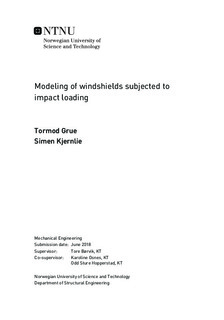| dc.contributor.advisor | Børvik, Tore | |
| dc.contributor.advisor | Osnes, Karoline | |
| dc.contributor.advisor | Hopperstad, Odd Sture | |
| dc.contributor.author | Grue, Tormod | |
| dc.contributor.author | Kjernlie, Simen | |
| dc.date.accessioned | 2019-09-11T08:35:20Z | |
| dc.date.created | 2018-06-10 | |
| dc.date.issued | 2018 | |
| dc.identifier | ntnudaim:19606 | |
| dc.identifier.uri | http://hdl.handle.net/11250/2614934 | |
| dc.description.abstract | Modern windshields are made of laminated glass, which consists of two glass panes bonded together with a polymer interlayer. The interlayer improves performance in many areas compared to monolithic glass. The post-fracture strength is increased due to the elastic properties of the interlayer and the number of glass fragments projected in the event of dynamic failure is reduced. Impact behavior of laminated glass has been found to be complex and this thesis aims to improve the understanding of the subject, both experimentally and numerically. Impact experiments on PVB-laminated glass have been performed in an Instron drop tower, and numerical simulations using the FE-code IMPETUS Afea Solver have been conducted.
Experiments were performed in the SIMLab research facilities at NTNU, where force measurements and high-speed footage were extracted. An aluminium impactor weighing 6.55kg was used and impact velocities ranged from 2ms-1 to 14ms-1. No fracture occurred at the lowest speed while perforation was observed at the highest. Oscillating force behavior was observed in all tests and correlations between the force history and visual crack propagation were found.
A numerical model was set up in IMPETUS, where node splitting was used for modeling fracture in the glass. Experiments from the literature were used to calibrate the material model for the PVB interlayer and delamination model. Preliminary studies led to a base model that was used in a parametric study. Parameters in the fracture criterion for the glass and in the delamination model were found to be influential for the impact response. Finally, a new set of input parameters were recommended for further use. The recommended parameters reproduced quantitative and qualitative experimental results well for impact velocities over 10ms-1. | en |
| dc.language | eng | |
| dc.publisher | NTNU | |
| dc.subject | Produktutvikling og produksjon, Industriell mekanikk | en |
| dc.title | Modeling of windshields subjected to impact loading | en |
| dc.type | Master thesis | en |
| dc.source.pagenumber | 185 | |
| dc.contributor.department | Norges teknisk-naturvitenskapelige universitet, Fakultet for ingeniørvitenskap,Institutt for konstruksjonsteknikk | nb_NO |
| dc.date.embargoenddate | 2021-06-10 | |

